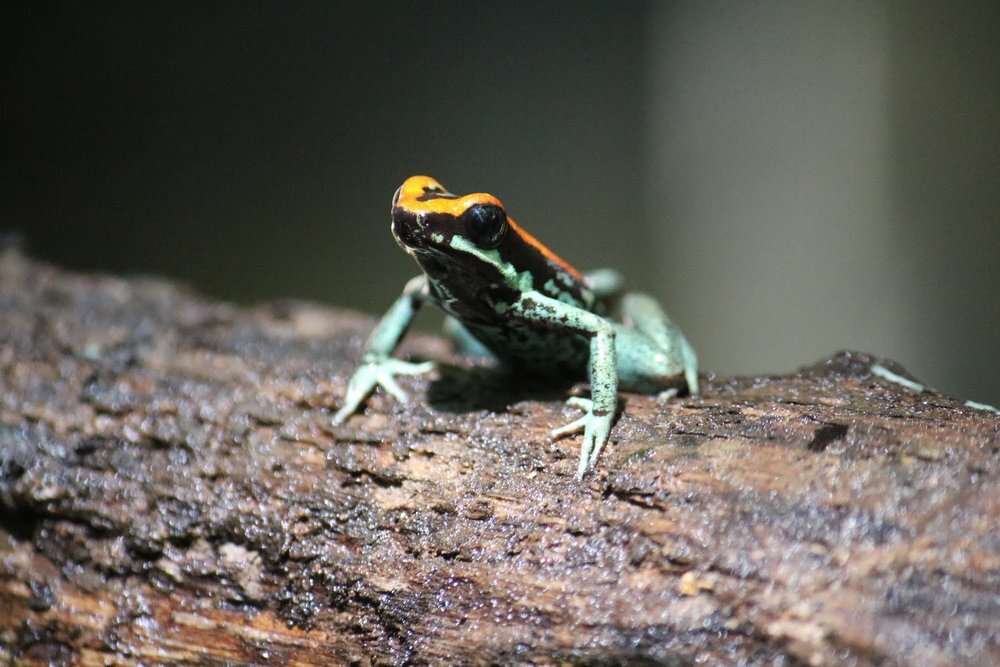In search of the endangered frog
told by Bethan (Resident Biologist from the University of Cambridge)
We recently hosted Marina Garrido Priego, the Herpetology Programme Coordinator at Osa Conservation, a nonprofit organization dedicated to protecting the globally significant biodiversity of the Osa Peninsula and Golfo Dulce. Marina visited the Retreat as part of her efforts to conserve the Golfodulcean Poison Dart Frog (Phyllobates Vittatus).
This striking frog is endemic to the region around Golfo Dulce, meaning that is found nowhere else in the world. Spotting it can be difficult and sightings of this tiny amphibian are rare. But here at Golfo Dulce Retreat, we are privileged to see this frog on most hikes into our rainforest reserve. The frog is beautifully patterned and something of an emblem for the region. It is also in need of protection. The IUCN lists it as endangered, with much more research needed to understand the frog itself and the challenges it faces. Threatened by habitat loss, mining, pollution and the wildlife trade, very little is known about the species so it is difficult to motivate conservation policies.
Golfodulcean Poison Dart Frog (Phyllobates Vittatus)
Herpetology Programme Coordinator at Osa Conservation
Marina is looking to change this. With dual aims of education and research, Marina hopes the Herpetology Programme will inspire positive local attitudes and build up enough evidence about the frog to get the need for conservation actions recognised in policy.
We invited Marina to accompany us on a trip to Golfo Dulce Retreat’s waterfall, which is home to a small population of Golfodulcean Poison Dart Frog (Phyllobates Vittatus). Finding and verifying all the populations around the gulf is key to creating an accurate, up-to-date map of the species distribution - essential for making a case for the frog’s conservation. Further studies on the many more unknown aspects of the frog, such as behaviour, can build on this foundation.
Our hike was filled with bird sightings, from a pair of Baird’s trogons to a nesting great curassow. At the waterfall, the Golfodulcean Poison Dart Frog (Phyllobates Vittatus) is usually straightforward to find: it tends to sit tucked under rocks close to the water and calls with a charming high-pitched trill. Of course this time, the frog was exceptionally elusive – as if it could sense our plans and was determined to thwart them. Thankfully, an extended search eventually uncovered the poison jewel. In fact, it even cooperated with a closer examination and some photos, by accepting encouragement to hop on top of a log where it could be more clearly observed.
Marina was excited to see for herself what we had described earlier: our population in Piedras Blanca National Park has a slightly different colour pattern to the populations on the peninsula. This is why the frogs you see at our waterfall appear more brightly coloured than pictures you might find online – the most obvious difference being the much thicker orange bands along the frog’s back. The exact cause of this difference can be added to the list of mysteries to be solved about this enigmatic creature.
Later that day, Marina gave a presentation back at Golfo Dulce Retreat. Starting with the bigger picture of Osa Conservation’s work, she took us through her programme on the Golfodulcean Poison Dart Frog. It was a whirlwind tour of the importance of the species, the existing knowledge, and her current research. Excitingly, her recent observations of the frog’s response to being disturbed indicate complex behaviours waiting to be discovered. To round off the talk, Marina presented some eye-opening insights into the dangers posed to this frog by human activities.
Despite the challenges, there is hope for the Golfodulcean Poison Dart Frog. Marina is raising awareness among the local people, and the research by her program will be used to generate an action plan for conserving the species. As she explained, the most important thing we can do to help is to document sightings of the frog on the citizen science app iNaturalist. These records are invaluable to researchers, who can use the data to draw accurate distribution maps (though the exact locations of populations of endangered species are otherwise kept confidential by the app, to protect them from poaching and trading). Scientific papers are already being published using data from iNaturalist, in many different species. It is also designed to be a community tool where people can help each other identify plants and wildlife.
It was great to have Marina visit us, and to learn so much more about one of the most endearing animals found at Golfo Dulce Retreat. If you stay with us, your best chance of seeing this unique frog is to take a hike to the waterfall with our guide. We hope to stay connected with Osa Conservation and do what we can to contribute to the conservation of the Golfo Dulce poison frog.










